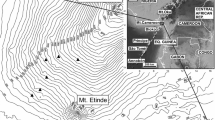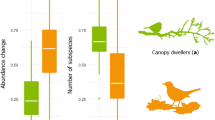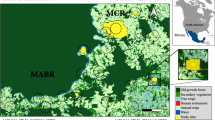Abstract
Understanding of animal responses to dynamic resource landscapes is based largely on research on temperate species with small body sizes and fast life histories. We studied a large, tropical mammal with an extremely slow life history, the Western Bornean orangutan (Pongo pygmaeus wurmbii), across a heterogeneous natural landscape encompassing seven distinct forest types. Our goals were to characterize fluctuations in abundance, test hypotheses regarding the relationship between dispersion dynamics and resource availability, and evaluate how movement patterns are influenced by abiotic conditions. We surveyed abundance in Gunung Palung National Park, West Kalimantan, Indonesia, for 99 consecutive months and simultaneously recorded weather data and assessed fruit availability. We developed a Bayesian hierarchical distance sampling model to estimate population dispersion and assess the roles of fruit availability, rainfall, and temperature in driving movement patterns across this heterogeneous landscape. Orangutan abundance varied dramatically over space and time. Each forest type was important in sustaining more than 40% of the total orangutans on site during at least one month, as animals moved to track asynchronies in fruiting phenology. We conclude that landscape-level movements buffer orangutans against fruit scarcity, peat swamps are crucial fallback habitats, and orangutans’ use of high elevation forests is strongly dependent on abiotic conditions. Our results show that orangutans can periodically occupy putative-sink habitats and be virtually absent for extended periods from habitats that are vitally important in sustaining their population, highlighting the need for long-term studies and potential risks in interpreting occurrence or abundance measures as indicators of habitat importance.




Similar content being viewed by others
Data availability
All data necessary to reproduce our results are available at figshare.com: DOI m10.6084/m9.figshare.14731866.
Code availability
All code necessary to reproduce our results are available at figshare.com https://doi.org/10.6084/m9.figshare.14731890
References
Altmann SA (1974) Baboons, space, time, and energy. Am Zool 14:221–248
Avgar T, Mosser A, Brown GS, Fryxell JM (2013) Environmental and individual drivers of animal movement patterns across a wide geographical gradient. J Anim Ecol 82:96–106
Boyce MS, Vernier PR, Nielsen SE, Schmiegelow FKA (2002) Evaluating resource selection functions. Ecol Model 157:281–300
Boyce MS, Johnson CJ, Merrill EH et al (2016) Can habitat selection predict abundance? J Anim Ecol 85:11–20
Boyko RH, Marshall AJ (2010) Using simulation models to evaluate ape nest survey techniques. PLoS ONE 5:754
Brockman DK, van Schaik CP (eds) (2005) Seasonality in primates: studies of living and extinct human and non-human primates. Cambridge University Press, Cambridge
Buckland ST, Anderson D, Burnham K et al (2001) Introduction to distance sampling: estimating abundance of biological populations. Oxford University Press, Oxford, U.K.
Buij R, Wich SA, Lubis AH, Sterck EHM (2002) Seasonal movements in the Sumatran orangutan (Pongo pygmaeus abelii) and consequences for conservation. Biol Cons 107:83–87
Cannon CH, Leighton M (2004) Tree species distributions across five habitats in a Bornean rain forest. J Veg Sci 15:257–266
Cannon CH, Curran LM, Marshall AJ, Leighton M (2007a) Long-term reproductive behaviour of woody plants across seven Bornean forest types in the Gunung Palung National Park (Indonesia): suprannual synchrony, temporal productivity and fruiting diversity. Ecol Lett 10:956–969
Cannon CH, Curran LM, Marshall AJ, Leighton M (2007b) Beyond mast-fruiting events: Community asynchrony and individual dormancy dominate woody plant reproductive behavior across seven Bornean forest types. Curr Sci 00113891(93):1558–1566
Chapman CA, Valenta K, Bonnell TR et al (2018) Solar radiation and ENSO predict fruiting phenology patterns in a 15-year record from Kibale National Park, Uganda. Biotropica 50:384–395
Charnov EL, Orians GH, Hyatt K (1976) Ecological implications of resource depression. Am Nat 110:247–259
Clucas B, McHugh K, Caro T (2008) Flagship species on covers of US conservation and nature magazines. Biodiv Cons 17:1517–1528
Corlett RT (2017) Frugivory and seed dispersal by vertebrates in tropical and subtropical Asia: an update. Glob Ecol Conserv 11:1–22
Curran LM, Leighton M (2000) Vertebrate responses to spatiotemporal variation in seed production of mast-fruiting Dipterocarpaceae. Ecol Mono 70:101–128
Dillis C, Beaudrot L, Clink DJ et al (2015) Modeling the ecological and phenological predictors of fruit consumption by gibbons (Hylobates albibarbis). Biotropica 47:85–93
Djojosudharmo S, van Schaik CP (1992) Why are orangutans so rare in the highlands? Altitudinal changes in a Sumatran forest. Trop Biodivers 1:11–22
Fawzi NI, Husna VN, Helms JA (2018) Measuring deforestation using remote sensing and its implication for conservation in Gunung Palung National Park, West Kalimantan, Indonesia. IOP Conf Ser Earth Environ 149:38
Gregory SD, Brook BW, Goossens B et al (2012) Long-term field data and climate-habitat models show that Orangutan persistence depends on effective forest management and greenhouse gas mitigation. PLoS ONE 7:e43846
Husson SJ, Wich SA, Marshall AJ et al (2009) Orangutan distribution, density, abundance and impacts of disturbance. In: Wich SA, Utami Atmoko SS, Mitra Setia T, van Schaik CP (eds) Orangutans: geographic variation in behavioral ecology and conservation. Oxford University Press, Oxford, pp 77–96
Johnson AE, Knott CD, Pamungkas B et al (2005) A survey of the orangutan (Pongo pygmaeus wurmbii) population in and around Gunung Palung National Park, West Kalimantan, Indonesia based on nest counts. Biol Cons 121:495–507
Kanamori T, Kuze N, Bernard H et al (2017) Fluctuations of population density in Bornean orangutans (Pongo pygmaeus morio) related to fruit availability in the Danum Valley, Sabah, Malaysia: a 10-year record including two mast fruitings and three other peak fruitings. Primates 58:225–235
Karr JR, Freemark KE (1983) Habitat selection and environmental gradients: dynamics in the “stable” tropics. Ecology 64:1481–1494
Kellner K (2016) jagsUI: A Wrapper Around “rjags” to Streamline “JAGS” Analyses. https://CRAN.R-project.org/package=jagsUI. Accessed 3 Aug 2020
Kelt DA, Heske EJ, Lambin X et al (2019) Advances in population ecology and species interactions in mammals. J Mammal 100:965–1007
Kéry M, Royle JA (2016) Applied hierarchical modeling in ecology. Academic Publishers, Waltham
Kinnaird MF, O’Brien TG (2005) Fast foods of the forest: the influence of figs on primates and hornbills across Wallace’s line. In: Lawrence Dew J, Boubli JP (eds) Tropical fruits and frugivores: the search for strong interactors. Springer, Dordrecht, pp 155–184
Knott CD (2001) Female reproductive ecology of the apes: implications for human evolution. In: Ellison PT (ed) Reproductive ecology and human evolution, pp 429–463
Knott C, Beaudrot L, Snaith T et al (2008) Female-female competition in Bornean orangutans. Int J Primatol 29:975–997
Kumagai T, Kanamori H, Yasunari T (2013) Deforestation-induced reduction in rainfall. Hydrol Process 27:3811–3814
Leighton M (1993) Modeling dietary selectivity by Bornean orangutans: evidence for integration of multiple criteria in fruit selection. Int J Primatol 14:257–313
Leighton M, Leighton DR (1983) Vertebrate responses to fruiting seasonality within a Bornean rain forest. In: Whitmore STC, Chadwick AC (eds) Tropical rain forest: ecology and management, vol 2. Blackwell Scientific Publications, Palo, pp 181–196
Manly BF, McDonald L, Thomas D et al (2002) Resource selection by animals: statistical design and analysis for field studies, 2nd edn. Kluwer Academic Publishers, Dordrecht
Marshall AJ (2009) Are montane forests demographic sinks for Bornean white-bearded gibbons Hylobates albibarbis? Biotropica 41:257–267
Marshall AJ (2018) Conservation science in the tropics: why so much ecological research is useless, and why we need more of it. In: Primatology, bio-cultural diversity and sustainable development in tropical forests. UNESCO, Mexico City, Mexico
Marshall AJ, Meijaard E (2009) Orang-utan nest surveys: the devil is in the details. Oryx 43:416–418
Marshall AJ, Wich SA (2016) Some future directions for primate conservation research. In: Wich SA, Marshall AJ (eds) An introduction to primate conservation. Oxford University Press, Oxford, pp 287–296
Marshall AJ, Wrangham RW (2007) Evolutionary consequences of fallback foods. Inter J Primatol 28:1219–1235
Marshall AJ, Ancrenaz M, Brearley FQ et al (2009) The effects of forest phenology and floristics on populations of Bornean and Sumatran orangutans. In: Wich SA, Utami Atmoko SS, Mitra Setia T, van Schaik CP (eds) Orangutans: geographic variation in behavioral ecology and conservation. Oxford University Press, Oxford, pp 97–118
Marshall AJ, Beaudrot L, Wittmer HU (2014) Responses of primates and other frugivorous vertebrates to plant resource variability over space and time at Gunung Palung National Park. Int J Primatol 35:1178–1201
Mason TH, Fortin D (2017) Functional responses in animal movement explain spatial heterogeneity in animal–habitat relationships. J Anim Ecol 86:960–971
Mathewson P, SpeharS ME, Nardiyono P, Sasmirul A, Sudiyanto O, Sulhnudin J, Jumali MAJ (2008) Evaluating orangutan census techniques using nest decay rates: implications for population estimates. Ecol Appl 18:208–221
McAlpine CA, Johnson A, Salazar A et al (2018) Forest loss and Borneo’s climate. Environ Res Lett 13:044009
McPeek MA, Holt RD (1992) The evolution of dispersal in spatially and temporally varying environments. Am Nat 140:1010–1027
Meijaard E, Wich SA, Ancrenaz A, Marshall AJ (2012) Not by science alone: why orangutan conservationists must think outside the box. Ann NY Acad Sci 1249:29–44
Mitra Setia T, Delgado RA, Utami Atmoko SS et al (2009) Social organization and male-female relationships. In: Wich SA, Utami Atmoko SS, Mitra Setia T, van Schaik CP (eds) (2009) Orangutans: geographic variation in behavioral ecology and conservation. Oxford University Press, Oxford, pp 245–253
MoE (2007) Indonesia country report: climate variability and climate change, and their implication. Indonesian Ministry of Environment, Jakarta
Oliver T, Roy DB, Hill JK et al (2010) Heterogeneous landscapes promote population stability. Ecol Lett 13:473–484
Page SE, Siegert F, Rieley JO et al (2002) The amount of carbon released from peat and forest fires in Indonesia during 1997. Nature 420:61–65
Paoli GD, Wells PL, Meijaard E, Struebig MJ, Marshall AJ, Obidzinski K, Slik JF (2010) Biodiversity in the REDD. Why efforts to reduce anthropogenic carbon emissions from forest may undermine long-term biodiversity conservation in Indonesia. Carbon Balance Manag 5:7
Plummer M (2003) rjags: Bayesian Graphical Models Using MCMC. Retrieved from http://cran.r-project.org/package=rjags. Accessed 3 Aug 2020
Presley SJ, Cisneros LM, Klingbeil BT, Willig MR (2019) Landscape ecology of mammals. J Mammal 100:1044–1068
Pulliam HR (1988) Sources, sinks, and population regulation. Am Nat 132:652–661
R Core Team (2017) R: a language and environment for statistical computing. R Foundation for Statistical Computing, Vienna
Rosenzweig ML (1991) Habitat selection and population interactions: the search for mechanism. Am Nat 137:S5–S28
Shine R, Brown GP (2008) Adapting to the unpredictable: reproductive biology of vertebrates in the Australian wet–dry tropics. Philos Trans R Soc Lond B 363:363–373
Singleton I, van Schaik CP (2001) Orangutan home range size and its determinants in a Sumatran swamp forest. Int J Primatol 22:877–911
Spehar SN, Sheil D, Harrison T, Louys J, Ancrenaz M, Marshall AJ, Meijaard E (2018) Orangutans venture out of the rainforest and into the Anthropocene. Sci Adv 4(6):e1701422
Struebig MJ, Fischer M, Gaveau DL et al (2015a) Anticipated climate and land-cover changes reveal refuge areas for Borneo’s orang-utans. Global Change Biol 21:2891–2904
Struebig MJ, Wilting A, Gaveau DLA et al (2015b) Targeted conservation to safeguard a biodiversity hotspot from climate and land-cover change. Curr Biol 25:372–378
Sugardjito J, Te Boekhorst IJ, Van Hooff JARAM (1987) Ecological constraints on the grouping of wild orangutans (Pongo pygmaeus) in the Gunung Leuser National Park, Sumatra, Indonesia. Int J Primatol 8:17–41
te Boekhorst IJ, Schürmann CL, Sugardjito J (1990) Residential status and seasonal movements of wild orang-utans in the Gunung Leuser Reserve (Sumatera, Indonesia). Anim Behav 39:1098–1109
Van Moorter B, Bunnefeld N, Panzacchi M et al (2013) Understanding scales of movement: animals ride waves and ripples of environmental change. J Anim Ecol 82:770–780
van Noordwijk MA, Atmoko SS, Knott CD et al (2018) The slow ape: high infant survival and long interbirth intervals in wild orangutans. J Hum Evol 25:38–49
Vogel ER, Harrison ME, Zulfa A et al (2015) Nutritional differences between two orangutan habitats: implications for population density. PLoS ONE 10:e0138612
Wich SA, van Schaik CP (2000) The impact of El Nino on mast fruiting in Sumatra and elsewhere in Malesia. J Trop Ecol 16:563–577
Wich SA, Utami Atmoko SS, Mitra Setia T, van Schaik CP (eds) (2009) Orangutans: geographic variation in behavioral ecology and conservation. Oxford University Press, Oxford
Wisdom MJ, Nielson RM, Rowland MM, Proffitt KM (2020) Modeling landscape use for ungulates: forgotten tenets of ecology, management, and inference. Front Ecol Evol 8:1–9
Wong ST, Servheen C, Ambu L, Norhayati A (2000) Impacts of fruit production cycle on Malayan sun bears and bearded pigs in lowland tropical rainforest of Borneo. J Trop Ecol 21:627–639
Yatagai A, Kamiguchi K, Arakawa O et al (2012) APHRODITE: constructing a long-term daily gridded precipitation dataset for Asia based on a dense network of rain gauges. Bull Am Meteorol Soc 93:1401–1415
Zamzani F, Onda N, Yoshino K, Masuda M (2009) Deforestation and agricultural expansion processes in Gunung Palung National Park, West Kalimantan, Indonesia. Jurnal Manajemen Hutan Tropika 15:24–31
Acknowledgements
We gratefully acknowledge the many constructive comments provided by the handling editor and three reviewers. We thank field researchers Agus Trianto, Albani, M. Ali A. K., Busran A. D., Dika, John Harting, Sarah Jaffe, Lande, Sylvain Lemoine, Mi’an, Edward Tang, Jon Sweeney, Surya, and Zakaria. Our thanks to AJM’s Indonesian counterparts and supporting institutions: the Ministry of Research and Technology / National Research and Innovation Agency, the Ministry of Forestry’s Directorate General of Forest Protection and Nature Conservation, the Indonesian Institute of Sciences, Universitas Nasional, Universitas Tanjungpura, and the Gunung Palung National Park Bureau.
Funding
Our work at Gunung Palung has been supported by funding from University of California, Davis, University of Michigan, Victoria University of Wellington, the Chinese Academy of Sciences, Xishuangbanna Tropical Botanical Garden, Hellman Foundation, Leakey Foundation, Orangutan Conservancy, Fulbright Foundation, Mohamed bin Zayed Species Conservation Fund, and the AZA Ape TAG Initiative.
Author information
Authors and Affiliations
Contributions
AJM, ML, LB, KLF, and HUW designed the study. AJM and HUW raised funds for data collection; AJM, LGB, ES, TWS, and TMS collected the data and/or provided logistical support; LB, KLF, LGB, MTF, and AJM extracted data and contributed R code; MTF and EFZ developed the Bayesian hierarchical distance sampling model; AJM and HUW wrote the manuscript; AJM produced the figures. All authors contributed to the drafts and gave final approval for publication.
Corresponding author
Ethics declarations
Conflict of interest
The authors declare that they have no conflict of interest.
Ethics approval
All applicable institutional and/or national guidelines for the care and use of animals were followed.
Additional information
Communicated by Joanna E. Lambert.
Supplementary Information
Below is the link to the electronic supplementary material.
Rights and permissions
About this article
Cite this article
Marshall, A.J., Farr, M.T., Beaudrot, L. et al. Biotic and abiotic drivers of dispersion dynamics in a large-bodied tropical vertebrate, the Western Bornean orangutan. Oecologia 196, 707–721 (2021). https://doi.org/10.1007/s00442-021-04964-1
Received:
Accepted:
Published:
Issue Date:
DOI: https://doi.org/10.1007/s00442-021-04964-1




